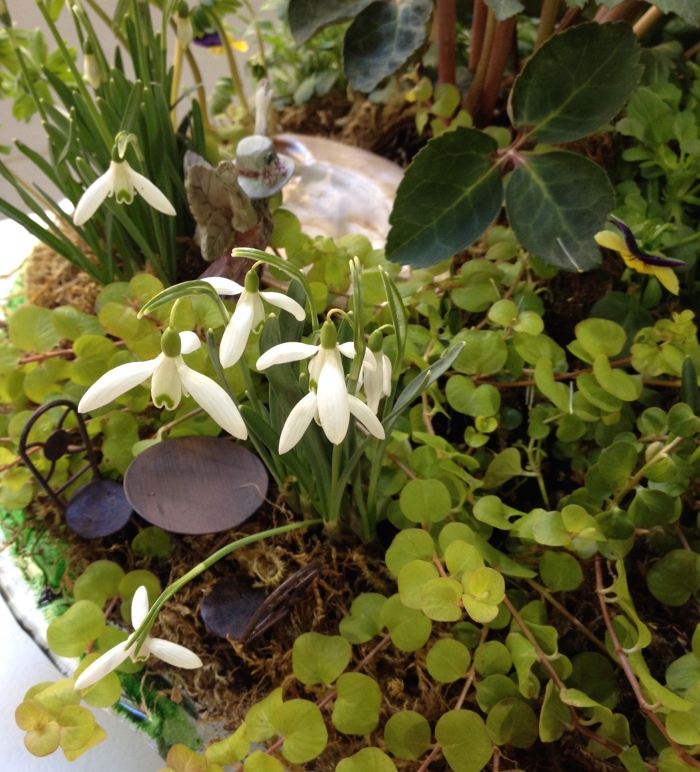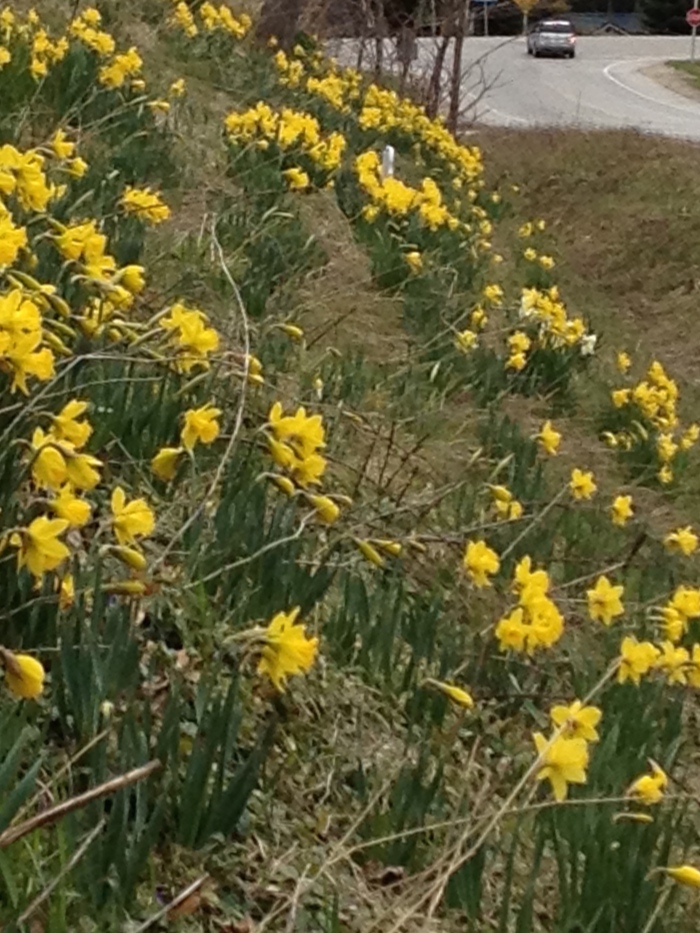 Ok. You just bought a brand new box of bulbs. Now what? How about shaking things up a bit by:
Ok. You just bought a brand new box of bulbs. Now what? How about shaking things up a bit by:
• breaking the rules.
• helping bees some more.
• easing a new bed into the garden.
• inviting a family of fairies to stay awhile.
• protecting a neighbouring ravine.
• sending a signal.
Or all of the above. Here are 6 fall bulb planting ideas that will have you thinking way outside the bulb box.
(And if you’re a little unsure of when to start popping those spring-flowering bulbs in the ground, hop over to my post “8 ways you’ll know it’s bulb time” for clues you can get from the crickets, the squirrels, the birds and even your dog.)
1. It’s OK to go for a polka dot effect. It’s actually a thing now.
You’ve heard that old bulb-planting rule before–Plant bulbs close together in drifts to create a natural look and avoid a polka-dot effect. But when you underplant tall spring blooming bulbs like daffodils or tulips with a carpet of contrasting colour, a full-on polka dot effect can be gorgeous. For a great example of how this can work, check out The Telegraph’s interview with Alan Titchmarsh of BBC GardenWorld fame about his ‘secret’ garden. When you see the article, you may be tempted to stop at the first photo–a shot of lollipop topiary in huge urns flanked by a crowd of alliums. But scroll down to the last shot. There you’ll see hundreds of tulips, all in the same colour family and each bulb planted with plenty of space around it. This is the so-called polka dot effect at its most elegant. You can do this at home, even if you don’t have a huge estate like Alan’s. Try pairing a singe colour of tulip (or tulips within the same colour family as Alan did) with a shorter plant that can deliver an even carpet of solid, contrasting colour such as Forget-me-not, deep mauve Grape hyacinth or dark purple Crocus. For some great tall-and-short spring flower pairings (complete with photos, check out Gardenia.net’s Combining Tulips with Annuals and Perennials.
2. Serve up an early spring meal for bees
Snowdrops are a classic harbinger of spring but did you know they also offer much needed nourishment for bees early in the season? I’ve seen bees buzzing around my snowdrops (southwestern Ontario, Canadian gardening zone 6b) as early as February. Originally from Europe, Snowdrops (Galanthus nivalis) were introduced in North America as an ornamental and have since become naturalized in Ontario, as well as parts of the Canadian and U.S. eastern seaboards. Another popular spring bloomer that just happens to be very popular with bees is Crocus, (Crocus vernus). And it also has naturalized in parts of Ontario. While you’re at it, add some Grape hyacinth (Muscari botryoides) which has naturalized in parts of the west coast and eastern half of North America (including Ontario). If you plant all three of these little wonders you’ll be offering bees a full banquet that extends from very early spring (Snowdrops) through early spring (Crocus) and into mid spring (Grape Hyacinth).
3. Use spring flowering bulbs to transition a new garden bed
It’s easy to plant bulbs each fall in the same places with the idea of giving your garden a fresh hit of colour come spring. But you can also take advantage of the fact that bulbs can fill up a space fast with loads of eye-catching colour. So if you’ve just put the finishing touches on a new garden bed, complete with new, young (read small) plants, from evergreens to woody and herbaceous perennials, rely on spring flowering bulbs to get your bed through that awkward growing-in stage. You can easily move your bulbs as your plants begin to grow in size.
4. Bring a fairy-friendly garden indoors for a bit of green magic through the darkest winter months.
This container planting (below) was an entry at Canada Blooms 2016 last March. I love how these Snowdrops look like white umbrellas hovering over the teeny tiny cafe table and chairs. Just think of the fun you can have playing with proportions using spring-flowering bulbs. Not to mention the magic of spring can arrive at your home while the snow is still flying outside.
5. Think beyond your garden fence
Believe it or not, even pretty little spring flowers can turn invasive and wreak havoc with a ravine or woodland area. Take Siberian squill (Scilla sibirica), for example. You’ll often find Siberian squill in zones 5 and 6 (including southwestern Ontario) used instead of Blue Bells (Hyacinthoides non-scripta) to get an approximation of that quintessentially English carpet-of-blue-in-the-woods look. ‘Spring Beauty’, a common variety of Siberian squill, produces lovely, clear blue flowers with slightly larger blooms. Here’s the thing: Siberian squill is noted as a “Category 2” invasive in the GTA (Greater Toronto Area). That means, according to Urban Forest Associates Inc., “Exotic species that are highly invasive but tend to only dominate certain niches or do not spread rapidly from major concentrations.” The concern is that this plant can dominate in a forest understory thus pushing out native species.
The photo below is of my little patch of Puschkinia scilloides var. libanotica, more commonly known as Puschkinia or Striped squill. It’s not invasive. At least not yet. (More on the sticky issues of invasiveness in an upcoming post. Stay tuned.) As a relative of Siberian squill, Puschkinia shares the same size and flower shape but not Siberian squill’s all-over blue colouring. Instead, Puschikinia is white with a single strong true blue stripe running down each petal.
So the idea is to think beyond your fence. If you live in the city but are near to a ravine or wooded area, reconsider planting Siberian squill. If you live out in the country in zones 5 or 6, very definitely reconsider using Siberian squill. It’s a very popular fall planting bulb, I know. Its gorgeous flowers can cover a flower bed with a blanket of blue or sprig a lawn beautifully in early spring. But nowadays we have to start thinking about the impact our gardening choices make on the places all around us, not just within our own fences.
6. Use bulbs to make a statement
After a long, hard winter, spring flowers from bulbs can communicate much more than Hurray, it’s spring! Perhaps it’s because you can buy oodles of them and, without much difficulty, create a bright swath of smile-inducing blooms that stands out dramatically against an otherwise winter-ravaged landscape. They can be used for remembrance, for celebration, for declaring allegiance to your favourite team or even as a political statement. One of my favourite examples is just outside Owen Sound in southwestern Ontario (seen in the photo below). An embankment separating a large cemetery from the road that runs along its length is covered with yellow daffodils every spring. The display was planted in remembrance of a young woman who died of cancer. I don’t know her name but I do think of her, the loved ones she left behind, and the disease we all must fight, every time I drive by.
If you’re looking for a way to help celebrate Canada’s 150th birthday next year (2017), how about planting a large bed of red and white tulips? The story behind the association of tulip bulbs and this country is endearing. Get the background info and how-tos in my post on the Tulip Garden Giveaway.
So grab a trowel and some bulbs and start thinking outside the box. What will your fall bulb planting ideas grow into?









Pingback: The winter garden, only better | Ministry of the fence
All fine ideas. There are so many ways to make bulbs a joyful part of spring.
LikeLike
Thanks! I think the squirrels agree, too! 🙂
LikeLiked by 1 person